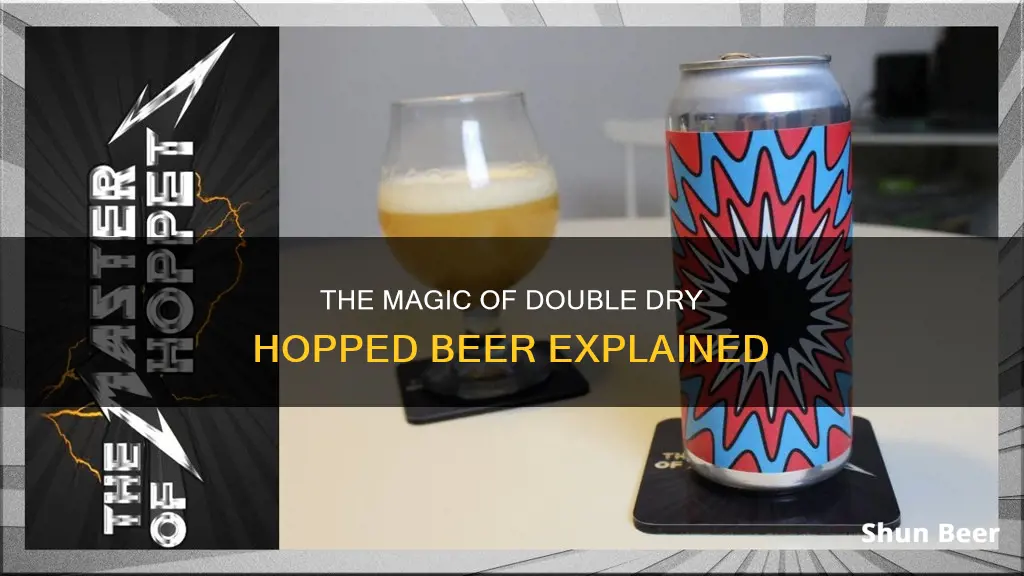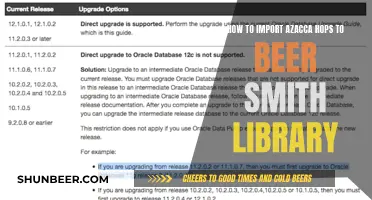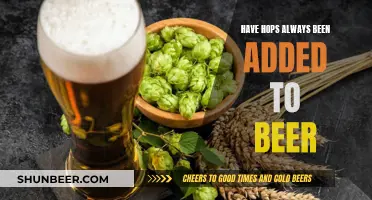
Double dry-hopped beer, or DDH, is a type of India Pale Ale (IPA) that has gained popularity among brewers and beer enthusiasts. The term double dry-hopped refers to either using twice the amount of hops or dry hopping the beer twice. This technique results in a beer with enhanced hop flavours and aromas without increasing bitterness. DDH beers, particularly New England-style IPAs, are known for their bold, vibrant hop flavours and are sought after by those who enjoy hoppy beers. While there is no standard definition for DDH, it has become a popular term in the craft beer world, often creating a buzz among enthusiasts.
| Characteristics | Values |
|---|---|
| Full form of DDH | Double Dry Hopped |
| Hops added | Twice the amount of hops or dry hopping twice |
| Taste | More flavour and aroma without the bitterness |
| Beer type | IPAs, DIPAs, NEIPAs, Pale Ales, Lagers, Sours, Hazy IPAs |
What You'll Learn

The history of double dry-hopped beer
Over time, the popularity of IPAs grew, and brewers sought to differentiate themselves while meeting the demand for hop-forward ales. This led to experimentation with dry hopping, a technique that infuses brighter, more vibrant hop flavors and aromas without the bitterness that comes from boiling hops. The rise of New England-style IPAs further emphasized the desire for big, vibrant hop aromas, and brewers began to explore "double dry hopping."
The term "double dry hopping" or "DDH" became increasingly popular, especially among trend-driven and trend-setting brewers. However, there is no standardized definition for double dry hopping, and it can mean different things to different brewers. Generally, it involves either dry hopping twice or using twice as many hops.
The ambiguity surrounding the term led to discussions among brewers and beer enthusiasts about its true meaning. Some argued that it was just a marketing buzzword, while others believed it had transcended its literal definition to become a distinct beer style. Despite the lack of a clear definition, double dry hopping became synonymous with a significant amount of late-addition hops, resulting in tropical fruit characteristics in the final beer.
With the rise of craft beer and the internet, beer drinkers sought out innovative breweries that embraced this technique. The demand for double dry-hopped beers drove the development of new hop varieties, and it became a sought-after style, especially for those craving an even hoppier experience than traditional IPAs offered.
Starting a Beer Hop Farm: A Beginner's Guide
You may want to see also

How double dry hopping affects beer taste
Dry hopping is the process of adding hops to a beer after boiling, during the primary or secondary fermentation phase. This technique is used to add more hop aroma and flavour to the beer without increasing bitterness.
The term "double dry hopping" is often abbreviated to "DDH" and has become increasingly popular. However, there is no consensus on what the term or the process entails. "Doubling" the dry hopping process can mean either dry hopping twice or using twice as much hops. It could also mean that a brewer has added an excessive amount of hops to a beer.
The term DDH is often associated with New England-style IPAs, which are known for their big, vibrant hop aromas without excessive bitterness. These beers often have a hazy or juicy appearance and are highly sought-after by beer enthusiasts.
The impact of double dry hopping on the taste of beer is somewhat unclear. Some brewers and beer enthusiasts argue that it results in a stronger hop flavour, while others claim that it is simply a marketing term that does not significantly affect the taste. Some taste tests have shown that participants were unable to reliably distinguish between beers that were double dry hopped and those that were not.
Ultimately, the effect of double dry hopping on beer taste may depend on various factors, including the type of beer, the amount of hops added, and the timing of the additions. While some brewers and drinkers may perceive a difference in taste, others may find the impact minimal.
Triple Hopping: Brewing Beer with Three Hop Additions
You may want to see also

The process of double dry hopping
The term "double dry hopping" is not cumulatively defined, and different brewers may have different interpretations of what it means. Some brewers may use the term to mean that they have added an extremely large amount of hops to a beer, while others may use it to refer to a specific process, such as adding hops to the beer on two separate occasions.
Hops and Hormones: The Estrogen-Beer Link Explained
You may want to see also

The difference between double dry-hopped and double IPA
Dry hopping is the process of adding hops to a beer after the boil, during the fermentation process. This is done to boost the hop aroma without increasing the bitterness. The term "double dry-hopped" (DDH) is ambiguous and can mean either that the beer has been dry hopped twice or with twice the amount of hops.
A double IPA (DIPA) is a stronger version of a regular IPA, with double the malt and hops, and a higher alcohol content (8-10%). A DIPA can also be DDH, but the terms are not interchangeable. A beer can be DDH without being a DIPA, and a DIPA can be made without being DDH.
DDH is a term used to describe the process of dry hopping, and the impact this has on the flavour and aroma of the beer. On the other hand, DIPA refers to the strength and alcohol content of the beer, which will be higher than a regular IPA.
To clarify, a double dry-hopped beer will have been dry hopped either twice, or with twice the amount of hops, or sometimes just with an extra amount of hops. A double IPA will have double the amount of malt and hops, and a higher alcohol content.
How NA Beer is Brewed Without Hops
You may want to see also

The future of double dry-hopped beer
- Innovation and Experimentation: The success and intrigue surrounding double dry-hopped (DDH) beers will likely spur brewers to further experimentation. This could involve tinkering with different hop varieties, playing with timing and amounts of hop additions, and exploring how DDH techniques interact with various beer styles beyond IPAs. The quest for unique flavors, aromas, and beer characteristics will drive innovation in the brewing industry.
- Marketing and Consumer Engagement: The DDH acronym has proven to be a powerful marketing tool, generating buzz and excitement among craft beer enthusiasts. Brewers will continue to leverage this term to create hype around new releases, limited editions, and collaborations. Social media will remain a key platform for building anticipation and engaging eager fans willing to line up for the latest DDH offerings.
- Style Evolution: While the term "double dry-hopped" initially caused confusion due to its flexible interpretation, a more standardized definition may emerge over time. Brewers might collectively agree on specific guidelines for what constitutes a DDH beer, bringing clarity to the term and helping consumers better understand what to expect from these brews.
- Collaboration and Community: The world of craft beer is known for its collaborative spirit, and DDH beers could foster even more collaboration among brewers. Shared experimentation, knowledge exchange, and the development of unique DDH recipes could strengthen the brewing community and lead to exciting new releases.
- Consumer Education: As DDH beers gain traction, consumers will become increasingly curious about the process and its impact on flavor. Brewers and beer experts may focus more on consumer education, explaining the nuances of dry hopping, the characteristics imparted by different hop varieties, and how these techniques elevate the drinking experience.
- Sustainability and Ingredient Sourcing: With the rising popularity of DDH beers, there may be a growing focus on sustainable hop farming practices and ethical sourcing. Brewers and hop growers could collaborate to ensure a consistent, high-quality supply of hops while also prioritizing environmental sustainability and fair labor practices.
- Pairing and Culinary Exploration: DDH beers, with their robust aromas and complex flavors, lend themselves well to food pairings and culinary adventures. Brewers and chefs might collaborate to create unique dining experiences, showcasing how DDH beers complement or contrast with different cuisines and flavor profiles.
- International Influence: While DDH beers are currently associated with specific regions, particularly New England-style IPAs, the technique could gain traction globally. Brewers in different countries may incorporate local ingredients, traditional brewing methods, and unique cultural influences to create innovative DDH styles that reflect their heritage.
Harvesting Hops for Beer: A Guide to Plucking the Perfect Cones
You may want to see also
Frequently asked questions
DDH stands for "Double Dry Hopped".
Double dry hopping is the act of adding hops to a beer twice during the brewing process, or adding twice the amount of hops during one stage of the process.
Hops are added to a beer after boiling, during the primary or secondary fermentation phase when the liquid is cool.
Double dry hopping imparts a stronger hop aroma and flavour to the beer without increasing bitterness.
Double dry hopping is commonly used for IPAs, particularly New England-style IPAs, but the process can be used for any style of beer.







